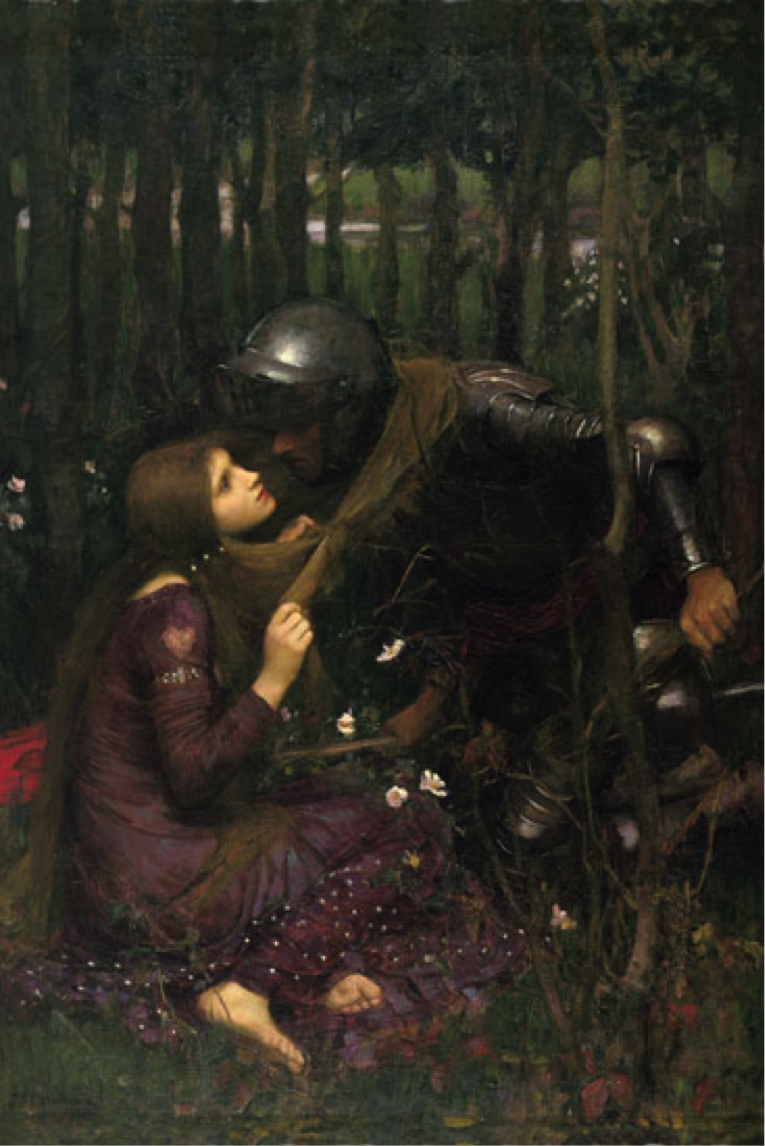La Belle Dame Sans Merci- 1819
John William Waterhouse
April 6, 1849 - February 10, 1917
Born in Rome, Italy. In 1854 the Waterhouse family moved back to England.
'Nino', as he was known, came from a family of artists, and naturally became involved.
His paintings usually involved women from both ancient Greek mythology and Arthurian folktales.Comparing Poem to Painting
The painting may be a reference to the IV stanza, when the knight tells the narrator how he met the 'Belle Dame'. The line 'her hair was long' is hyperbolized to symbolize the luring of the woman, and furthermore the fact that she is holding the knight close to him suggests the idea that she possesses him.
The woman is lit under a different light: brighter, almost extraneous to the light in the rest of the painting. She is pale, yet the light emanates from her and makes her glow. Her features are lit up, her gesture alluring, bewitching. Yet, the length of her hair is not usual: here again the supernatural is exposed and we understand that the Dame is cryptic. The knight is different however. He is kneeling, almost stooping over her. This shows that he consented to her flirting. His dark complexion contrasts the Dame's shine, but this is because he is hit with natural light, unlike her, whose light is intrinsic. The atmosphere is dark, the meadow is covered with trees, yet we can see the grasslands behind the small forest, which indicates that the Dame chose the darkest, most mysterious place to lure his victim.
This painting shows the Dame with the 'garland' and the other accessories, which indicates Dicksee did not stick to theit first encounter, like Waterhouse did. We see the knight 'in thrall', the Dame dressed in a red dress, symbolizing passion and lust, but the fact that she is riding the horse and the knight is not shows that the Dame is in charge, in control. The light is bright and the atmosphere is cheerful because of the use of bright colors. The difference is big in terms of the proxemics: in the Waterhouse painting, the Dame is deceiving, she is crouched at a corner, yet she is clinging on to her victim, trapping him with her hair; on the other hand, the second painting shows a triumphant Dame, sitting on the horse while she hypnotizes the knight and lures him, 'enthralls' him.
Romanticism is the essence of each piece. The passionate stares, charged with emotion illustrate the powerful meaning behind the stares, also both of the paintings are set in the wilderness, in the heart of nature. The colors of nature gleam and reflect the characters' colors, which indicates a oneness with nature that romanticism avidly preached.
The woman is lit under a different light: brighter, almost extraneous to the light in the rest of the painting. She is pale, yet the light emanates from her and makes her glow. Her features are lit up, her gesture alluring, bewitching. Yet, the length of her hair is not usual: here again the supernatural is exposed and we understand that the Dame is cryptic. The knight is different however. He is kneeling, almost stooping over her. This shows that he consented to her flirting. His dark complexion contrasts the Dame's shine, but this is because he is hit with natural light, unlike her, whose light is intrinsic. The atmosphere is dark, the meadow is covered with trees, yet we can see the grasslands behind the small forest, which indicates that the Dame chose the darkest, most mysterious place to lure his victim.
 |
| La Belle Dame Sans Merci, Frank Dicksee, circa 1902. |
Romanticism is the essence of each piece. The passionate stares, charged with emotion illustrate the powerful meaning behind the stares, also both of the paintings are set in the wilderness, in the heart of nature. The colors of nature gleam and reflect the characters' colors, which indicates a oneness with nature that romanticism avidly preached.

No comments:
Post a Comment